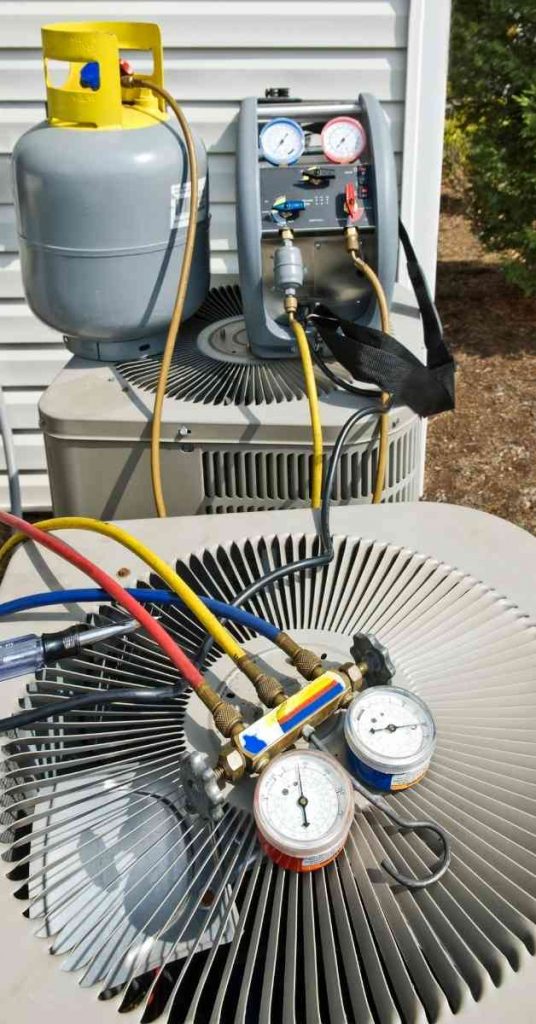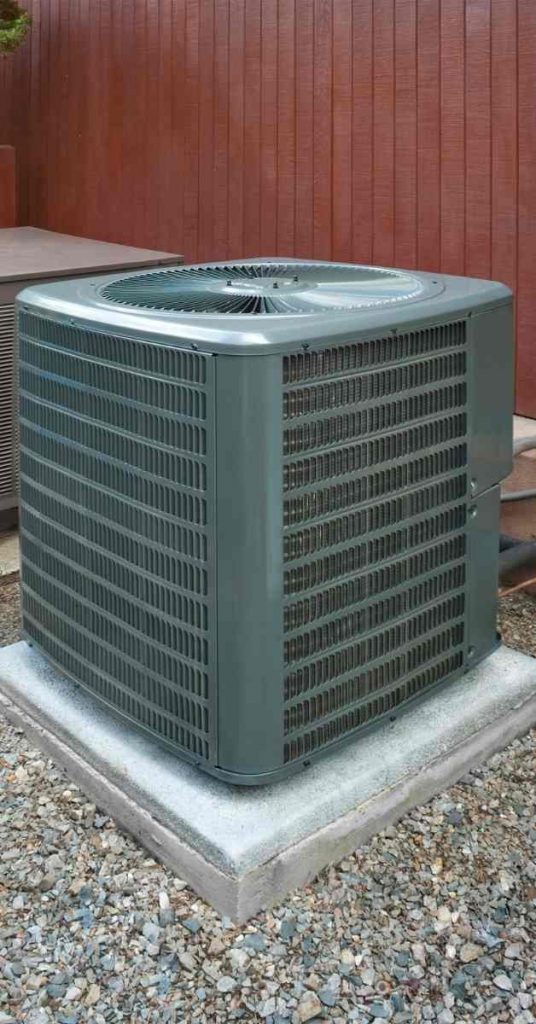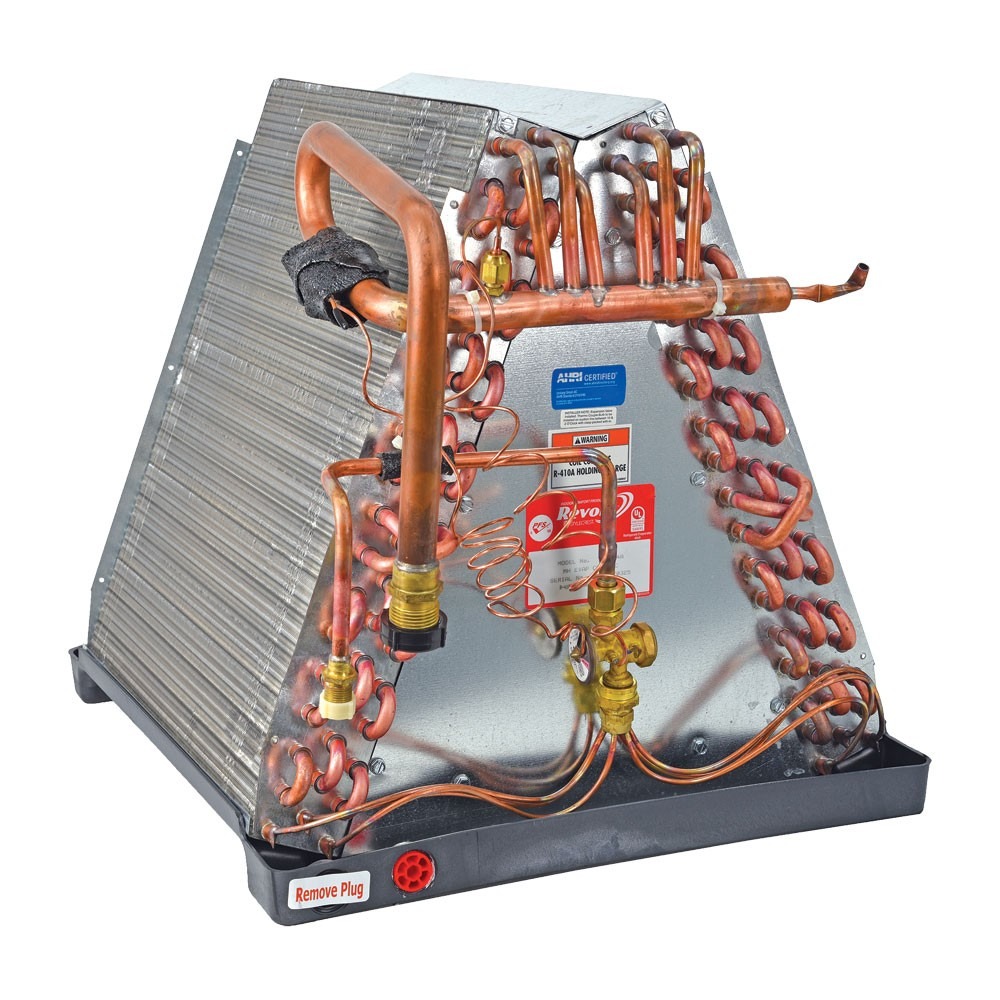
Here’s a summary of the main parts of an air conditioner and how they function:
- Evaporator Coil:
- Located inside the indoor unit, the evaporator coil is responsible for absorbing heat from the indoor air.
- It contains refrigerant, which evaporates as it absorbs heat, turning into a low-pressure, cold gas.
- Blower Fan:
- The blower fan is situated near the evaporator coil and circulates indoor air across the coil.
- As warm air passes over the cold evaporator coil, heat is transferred from the air to the refrigerant, cooling the indoor air.
- Compressor:
- The compressor is part of the outdoor unit and plays a central role in the refrigeration cycle.
- It pressurizes the low-pressure, cold refrigerant gas, raising its temperature and pressure significantly.
- Condenser Coil:
- The condenser coil, also in the outdoor unit, releases heat absorbed from indoor air.
- It facilitates the transfer of heat from the high-pressure refrigerant gas to the surrounding outdoor air.
- Expansion Valve (or Metering Device):
- Located between the evaporator and condenser coils, the expansion valve regulates the flow of refrigerant.
- It causes the high-pressure refrigerant to rapidly expand, reducing its temperature and pressure as it enters the evaporator coil.
- Refrigerant Lines:
- Copper or aluminum refrigerant lines connect the indoor and outdoor units, allowing the flow of refrigerant between the coils.
- Thermostat:
- The thermostat is the user interface that allows you to set the desired temperature.
- It communicates with the air conditioner to control when the system cycles on and off to maintain the set temperature.
- Air Filters:
- Air filters trap dust, particles, and allergens from the indoor air, improving air quality and preventing dirt buildup on the coils.
How They Function
- Cooling Cycle:
- The process begins with the blower fan drawing warm indoor air over the evaporator coil.
- The evaporator coil’s cold refrigerant absorbs heat from the air, cooling it.
- The now-cooled air is distributed back into the living space.
- Refrigeration Cycle:
- The absorbed heat causes the refrigerant to evaporate, turning into a low-pressure gas.
- The compressor pressurizes this gas, raising its temperature and pressure.
- The hot, high-pressure gas flows to the condenser coil in the outdoor unit.
- The condenser coil releases heat absorbed from the indoor air into the outdoor environment.
- As the refrigerant loses heat, it condenses back into a liquid.
- The expansion valve rapidly reduces the refrigerant’s pressure and temperature before it re-enters the evaporator coil, starting the cycle anew.
- Temperature Control:
- The thermostat continuously monitors the indoor temperature.
- When the temperature rises above the set point, the thermostat signals the air conditioner to cycle on.
- Once the desired temperature is reached, the system cycles off until it’s needed again.
Air Conditioning Parts and Functions
The following are the five basic parts of an air conditioning system:
1. Refrigerant

A refrigerant, also known as a coolant or its brand name Freon is the fluid that circulates between the various AC components, removing heat from indoors and throwing it outdoors.
Freon isn’t really a part but a main component of the air conditioning system. It is a special chemical and there is a reason why it is the preferred refrigerant and not water or any other fluid.
Freon has a very low boiling point compared to other fluids and that is very important in a cooling system. It is therefore able to change from a liquid state to a gas state and back to the liquid state fairly easily.
While water has a boiling point of 212 degrees Fahrenheit, the refrigerant used in air conditioning has a boiling point of about 40 degrees. That is a big difference
Cooling happens when the Freon (inside the evaporator coil) evaporates (turns from liquid to gas/vapor).
On hot days when we sweat, the sweat forms on our skins. As the sweat vaporizes away from the skin, a cooling sensation is created. The same reason dogs stick their tongues out when it is hot.
Freon enters the house in its liquid state and as it moves through the evaporator coils it changes into a gas/vapor after absorbing heat from the hot indoor air. The evaporation process inside the evaporator coil cools the air around it and the now cooled air is sent back to your living spaces.
2. Compressor

The compressor of an air conditioning system as I mentioned is found in the big outdoor unit but if you have a window or portable AC then it is part of the single unit.
You could say that a compressor is an air pump. It pressurizes the Freon which gives it the kinetic energy to circulate through the entire loop (the main components of an AC system form a closed-loop with the help of copper tubes).
When the refrigerant is leaving the evaporator coil, it is usually a low-pressure high temperature gas/vapor. It is therefore important to increase its temperature for the reasons I am going to explain below.
When you compress a gas, its pressure increases and its temperature also increases since the gas particles are now close together meaning there are more collisions. As the Freon exits the compressor, it is now a high-pressure superheated gas.
It is important for the temperature of the Freon to be more than the temperature of the surrounding air. Why is that though?
The reason for that is because heat is transferred from a point of high concentration to a point of low concentration. Remember that the refrigerant contains heat from the indoor air which it needs to dump to the surrounding so that it can go back for another round of cooling.
Older AC units have a piston condenser, which looks very much like the piston in your car engine. The piston moves up and down compressing the gas and sending it out to the condenser coil.
Modern AC units however use a scroll compressor. This compressor is made up of 2 scrolls, where one is ever stationary while the other rotates as fast or as slow as the motor speed is set.
As the refrigerant gas moves between the 2 scrolls, the channel reduces in size resulting in compression. These compressors are compact and since the motor speed can be controlled, they are very precise.
3. Condenser Coil

Again, the condenser coil is part of the outdoor unit unless you have a packaged air conditioning system. It derives its name from what it does: condensation.
Condensation is the process where a gas turns to its liquid state. Inside the condenser coil, the super hot and high-pressure refrigerant will lose its heat to the surrounding and then condense to its liquid state.
A condenser coil is basically a copper tube that is coiled back and forth many times. The reason for such many coils is to increase the surface area of the refrigerant in contact with the surrounding air for maximum heat exchange to occur.
The condenser coil comes equipped with a fan that is usually at the top of the coil. When the super hot gaseous refrigerant enters the condenser coil, the fan blows air over the coil which takes with it heat from the refrigerant.
The outside of the condenser unit has metal fins similar to those of a car radiator. These help in dissipation of heat to the surrounding.
Another important property of the refrigerant is that it goes back to its liquid state fairly easily. By the time it is exiting the condenser coil, the refrigerant is almost in its liquid state but also under high pressure.
In short, a condenser coil is a form of heat exchanger. Heat is transferred from the refrigerant to the surrounding. That is exactly why if you stand next to the condenser coil you will feel hot air being blown towards you.
4. Expansion Valve
After the now condensed refrigerant exits the condenser coil and before it enters the evaporator coil, it is passed through a restriction known as an expansion valve.
An expansion valve is a small opening like the nozzle of a spray bottle. So, why do we need an expansion valve in an air conditioning system?

The expansion valve regulates the amount of refrigerant entering the evaporator coil. That is very important.
If too much of the refrigerant enters the evaporator, not all of it will vaporize meaning some of it will go back to the compressor in its liquid state. And that will damage the compressor.
The expansion valve therefore ensures that only the right amount of refrigerant is allowed to enter the evaporator. Again, when not enough refrigerant is sent to the evaporator the house will be undercooled.
Also, although the refrigerant from the condenser is cold, it will not be cold enough. A great way of cooling it even further is by lowering its pressure.
As I said, increasing the pressure of a gas increases its temperature too. The opposite is also true. Lowering the pressure will reduce the temperature as well.
As the refrigerant is pushed through the expansion valve, its pressure reduces and its temperature falls drastically. The lower the temperature of the refrigerant the more effective the heat transfer from the hot indoor air will be.
Older air conditioning systems used to have a fixed-hole expansion valve. To control the amount of refrigerant going to the evaporator, the units would start and stop as needed. As you can imagine, that was less than ideal
Newer air conditioning systems incorporated a thermostatic expansion valve commonly known as a TXV. These valves has a bulb on the end of the evaporator coil where the refrigerant exits the evaporator on its way to the condenser.
The bulb senses the temperature of the refrigerant and automatically adjusts the size of the valve orifice. When the temperature of the refrigerant is super high, it signals the orifice to open wider and vice versa.
Modern air conditioning units have an electronic expansion valve which is even more precise. That means that no liquid refrigerant ever goes to the compressor and you will not experience overcooling or undercooling.
5. Evaporator Coil

An evaporator coil is located inside the house together with the expansion valve. That is where the hot air in your house is cooled and dissipated back to your living areas.
In a central air conditioning unit, the evaporator coil is located where it is less conspicuous and its shape looks like an A-frame with copper tubes coiled around it.
Your home will also have a thermostat located centrally in your house. When the thermostat senses the indoor air heating up, it signals all the air conditioner components to start running.
The evaporator coil fan pulls hot air from the room using return air ducts. The hot air from the house is first passed through filters where dust, lint and other impurities are removed.
The hot air is then blown over the now cold evaporator coil where the refrigerant absorbs the heat from it. The now cold air is then sent back to the different areas in your house through supply air ducts.
As the refrigerant absorbs heat from the air, it starts to heat up and ultimately evaporates and is sent back to the compressor. The whole cycles is repeated once more.
In the case of ductless air conditioners, the evaporator coil will be found mounted on the wall of the room it is intended to cool. Several evaporators can be connected to a single condenser unit.
As such, each room will have a separate thermostat which means that it is possible to cool the different rooms at different temperatures.
Portable air conditioners will need a hose to vent heat from the house through a window while window air conditioners dissipate their heat from the back of the unit.
Conclusion
And basically those are the main components of an air conditioner. I hope you found this guide helpful.
